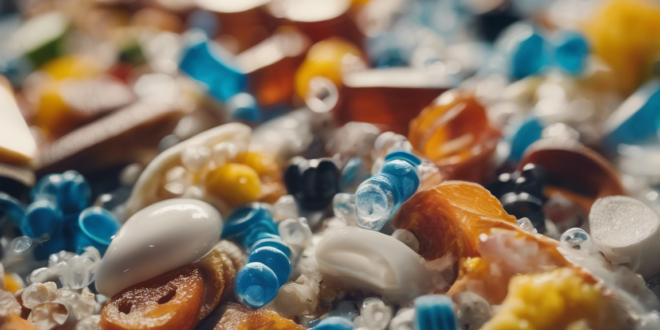The Top 10 Foods with Microplastics: A Comprehensive Guide to Protecting Your Health
In our modern world, microplastics have become an invisible threat lurking in our daily diet. These microscopic plastic particles, typically less than 5 millimeters in size, are contaminating our food supply at an alarming rate, raising serious concerns about long-term health implications. This comprehensive guide will explore the most common foods containing microplastics and provide practical strategies to minimize your exposure.
Understanding Microplastics: What You Need to Know
Microplastics are tiny plastic fragments that result from the breakdown of larger plastic materials or are intentionally manufactured for various industrial purposes. These minuscule particles have infiltrated nearly every aspect of our environment, from oceans and soil to the food we consume daily. Scientists have discovered that humans ingest thousands of microplastic particles each year, with potential consequences that are still being researched.
Top 10 Foods Most Contaminated with Microplastics
1. Seafood
Seafood tops the list of foods most contaminated with microplastics. Fish and shellfish are particularly vulnerable due to marine plastic pollution. Ocean ecosystems are saturated with plastic waste, which breaks down into microscopic particles that are then absorbed by marine life. When we consume seafood, we inadvertently consume these plastic particles.
2. Bottled Water
Ironically, bottled water contains significantly higher levels of microplastics compared to tap water. A shocking study revealed that a single plastic water bottle could contain approximately 10 plastic particles per liter. The plastic packaging itself contributes to contamination, with particles shedding into the water during production and storage.
3. Salt
Both sea salt and rock salt have been found to contain microplastic particles. Marine pollution has dramatically impacted salt production, with researchers discovering that even high-quality salts from around the world contain microscopic plastic fragments. This contamination occurs through environmental pollution and oceanic plastic waste.
4. Beer
Surprisingly, beer is another significant source of microplastic contamination. The brewing process and ingredients, particularly those derived from agricultural sources, can introduce microplastic particles. Research suggests that a single beer can contain up to several particles per liter.
5. Processed Foods
Processed and packaged foods are particularly susceptible to microplastic contamination. The extensive use of plastic packaging, processing equipment, and transportation containers increases the likelihood of plastic particle transfer into food products.
6. Honey
Natural honey has been found to contain microplastic particles, primarily due to environmental contamination. Bees collect nectar from various sources, potentially including areas with significant plastic pollution, which can result in microplastic accumulation in honey.
7. Fruits and Vegetables
Produce is not immune to microplastic contamination. Agricultural practices, plastic-based pesticide containers, and environmental pollution contribute to microplastic presence in fruits and vegetables. Even organic produce can contain these microscopic particles.
8. Dairy Products
Milk and dairy products have been found to contain microplastic particles. The contamination can occur through various stages of production, including packaging, processing, and environmental exposure of dairy cattle.
9. Tea Bags
Many tea bags are made with plastic-based materials that can release microplastic particles when exposed to hot water. Some brands use plastic sealants or entirely synthetic tea bags, increasing potential contamination.
10. Shellfish
Shellfish, particularly filter-feeding species like mussels and oysters, are especially prone to microplastic accumulation. These marine organisms directly filter seawater, inadvertently consuming and storing plastic particles in their tissues.
Health Risks Associated with Microplastic Consumption
While long-term health impacts are still being studied, preliminary research suggests potential risks including:
– Inflammation
– Cellular damage
– Potential hormone disruption
– Potential carcinogenic effects
– Immune system complications
Strategies to Minimize Microplastic Exposure
1. Choose Alternative Packaging
Opt for glass, stainless steel, or ceramic containers instead of plastic. These materials are less likely to shed microplastic particles and provide safer food storage options.
2. Filter Your Water
Invest in high-quality water filtration systems that can effectively remove microplastic particles. Reverse osmosis and activated carbon filters are particularly effective.
3. Reduce Processed Food Consumption
Choose fresh, whole foods and minimize packaged and processed food intake. This not only reduces microplastic exposure but also promotes overall nutritional health.
4. Select Sustainable Seafood
Choose seafood from sustainable sources and regions with lower plastic pollution. Look for certifications and recommendations from marine conservation organizations.
5. Use Natural Tea Alternatives
Select loose-leaf teas or brands using biodegradable tea bags. Avoid plastic-based tea packaging to minimize microplastic exposure.
Conclusion: Taking Control of Your Health
While completely eliminating microplastic exposure is challenging, informed choices can significantly reduce your risk. Stay educated, make conscious dietary decisions, and support environmental initiatives aimed at reducing plastic pollution.
Remember, your health is a product of the choices you make. By understanding microplastic contamination and taking proactive steps, you can protect yourself and contribute to broader environmental sustainability efforts.
 Good Calories Guide GoodCalories Guide focuses on nutrition, healthy eating, and overall wellness. The site offers practical insights into evidence-based dietary practices, including tips for specific lifestyles such as veganism, keto, and family-friendly meal planning. It also addresses unique nutritional needs for individuals with conditions like diabetes or food allergies, while providing quick and accessible recipes to make healthy living a sustainable and enjoyable choice.
Good Calories Guide GoodCalories Guide focuses on nutrition, healthy eating, and overall wellness. The site offers practical insights into evidence-based dietary practices, including tips for specific lifestyles such as veganism, keto, and family-friendly meal planning. It also addresses unique nutritional needs for individuals with conditions like diabetes or food allergies, while providing quick and accessible recipes to make healthy living a sustainable and enjoyable choice.


